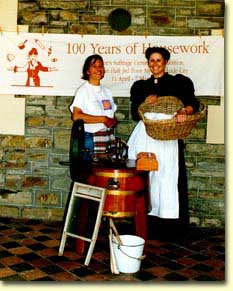
Political Awareness | In Parliament | The Workplace | Why South Australia?
The Aboriginal Voice | Cultural Diversity

 100
years of housework
100
years of housework
Media release by Rosemary Cadden and photograph courtesy Rosey Boehm.
A rusty, old outdoor "long drop" dunny was a novel addition to the 100 years of housework exhibition on display in the Rundle Mall Myer store—but it nearly didn't get there. The dunny, discovered in a field at Port Pirie north of Adelaide by one of the many scouts who spent months searching second-hand shops, historical museums, private homes and demolition sites for authentic Australian household items, disappeared before it could be collected.
Rescued from demolition, exhibition organisers arranged for it to be carefully transported to Adelaide in one piece - only to find it could not squeeze into the store lifts.
Spiders were discovered when it was dismantled and it was only after fumigation and re-assembly that the dunny took its place in the display among hundreds of props for the official opening on April 11.
The exhibition showed how technology, house designs and lifestyles had changed dramatically since the 1890s - but not so social attitudes.
Women won the vote 100 years ago, studies show that, a century later, they were still losing the household chores battle and bearing 80% of the load. "While technology has changed housework dramatically, it still has to be done - and done again - every day," Exhibition curator Dr Kay Rollison, of the University of Adelaide said. "housework is still unpaid, largely unrecognised, and mostly done by women."
The exhibition centred around three eras:
1890s - Too Heavy by Half: the era of kerosene lamps, wood stoves, scrubbing boards, homemade cleaning mixtures and the backyard chook shed.
1950s - My Mother Didn't Work: the era of electric toasters, frozen food, laminex, nylon fabric and the first Hills clothes hoist.
1990s - the Double Load: the era of microwave ovens, dishwashers, clothes driers and fast food.
The time warp in the Myer exhibition hall led visitors through a kitchen and laundry for each era. While many items were new to the hundreds of school children who walked through the exhibition, they evoked for many others memories of stoking the copper on washing day and the purchase of that first electric washing machine.

| Copyright and this website | Disclaimer | Privacy | Feedback | Accessibility | FOI This page last updated on Friday 11 April, 2014 15:16
|
State Library of South Australia |